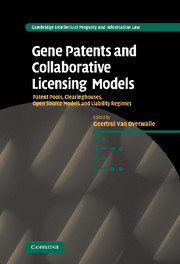 Gene Patents and Collaborative Licensing Models
Gene Patents and Collaborative Licensing Models from Part II - Clearinghouses
Published online by Cambridge University Press: 14 January 2010
Background
Both the existence and exploitation of human gene patents have gained wide attention. Although the controversy about the eligibility of patents in the field of human genetics remains, this primarily ethical debate has largely been ‘outlawed’ by the political international consensus to allow the registration of such patents as long as the general patentability requirements are fulfilled. Nevertheless, the voice of opponents of human gene patents is still regularly heard at various platforms and echoed in legislative proposals at both sides of the Atlantic. It remains to be seen to what extent this will actually lead to a reopening of the patentability debate and ultimately amendments in the patent legislation and granting policies. Some people would probably even argue that the policy of the patent offices actually already became more restrictive with regard to gene patents. In this paper I do not explicitly deal with the desirability of gene patents, rigorous application of patentability standards and patent scope, although I do recognize that these issues are intrinsically connected with the subject of this paper. However, as these topics are not the principal focus of this book, we will start from the status quo where gene patents have been and are granted globally and we will focus on the problems that granted patents might create with respect to their exploitation.
Moreover, clearinghouses are part of a spectrum of solutions which may remedy the problems described below. Research exemptions, compulsory licences and clearinghouses are just three of them.
To save this book to your Kindle, first ensure [email protected] is added to your Approved Personal Document E-mail List under your Personal Document Settings on the Manage Your Content and Devices page of your Amazon account. Then enter the ‘name’ part of your Kindle email address below. Find out more about saving to your Kindle.
Note you can select to save to either the @free.kindle.com or @kindle.com variations. ‘@free.kindle.com’ emails are free but can only be saved to your device when it is connected to wi-fi. ‘@kindle.com’ emails can be delivered even when you are not connected to wi-fi, but note that service fees apply.
Find out more about the Kindle Personal Document Service.
To save content items to your account, please confirm that you agree to abide by our usage policies. If this is the first time you use this feature, you will be asked to authorise Cambridge Core to connect with your account. Find out more about saving content to Dropbox.
To save content items to your account, please confirm that you agree to abide by our usage policies. If this is the first time you use this feature, you will be asked to authorise Cambridge Core to connect with your account. Find out more about saving content to Google Drive.